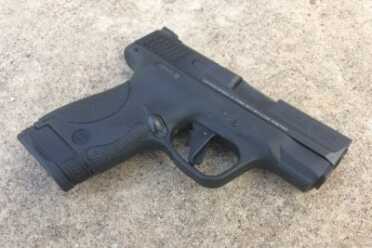
Unlike the factory trigger, the Apex Tactical trigger is constructed of aluminum, which gives it a solid, durable feel. The flat-faced trigger also helps encourage a straight-back trigger pull.
A smooth, consistent trigger pull can mean the difference between a hit and a miss. I get that. Still, sometimes I wonder: are aftermarket triggers worth the cost? Is $10 of metal really worth $200 when my gun already goes bang every time I pull the trigger?
If you’re heading down to the comments to give me a piece of your mind, hang with me. We might disagree about aftermarket triggers in general, but I think we can all agree about the Apex Tactical trigger for the Smith & Wesson M&P Shield. I was skeptical at first, but let me tell you—it’s worth the money.
I recently bought a Shield for concealed carry. The stock trigger is better than I expected, but I wanted something a little lighter. I want every component to be as effective as possible.
Towards that end, I purchased the Apex Tactical Flat-Faced Trigger and Duty/Carry Kit. The kit comes with everything you need to make your trigger lighter and, more importantly, smoother. Apex also designed the kit to provide a more consistent trigger pull and a more detectable reset, and to reduce pre-travel and over-travel by approximately 20%.
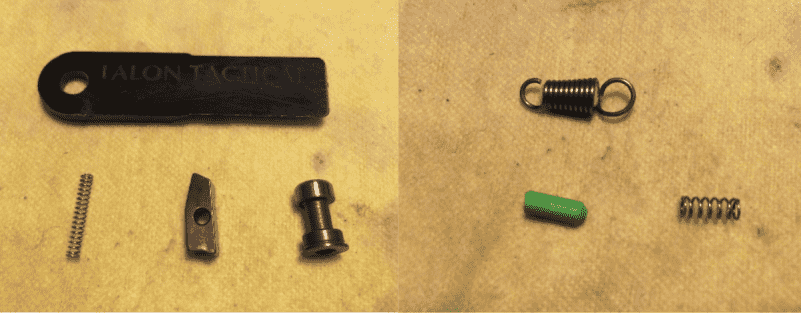
The duty/carry kit includes (from left to right in the pictures) a Talon Tactical sight installation tool, a lightened striker block spring, a fully machined sear, a polished striker block, a rated trigger return spring, a trigger slave pin, and a sear spring.
Before I get into the installation, I want to give you a sense of what the trigger felt like before the Apex Tactical kit. The trigger weighed in between 7 pounds and 7 pounds, 4 ounces. The trigger also wasn’t terribly smooth. The pull was OK, but I always felt an initial click before the full reset.
Here’s what you need for the installation:
- 1/8” roll pin punch
- 1/16” pin punch
- 3/32” pin punch
- Large brass punch
- Hammer with nylon face
- 1/16” Allen wrench
- Vice
Apex Tactical also offers an armorer’s block, tray, and punch, which you can purchase separately. I found these to be extremely helpful throughout the installation process, though they’re not entirely necessary as long as you have a punch set.
STEP 1

Begin by removing the slide, barrel, and barrel spring from the frame. If you don’t know how to do this, 1) you can find instructions in your user’s manual and 2) you need to clean your gun more frequently.
STEP 2

Remove the take-down lever. Important: Rotate the lever so that the tab on the lever fits through the notch in the frame. Once you align the tab and the notch, you should be able to pull the lever through both sides of the locking block.
STEP 3

Use a 1/8” roll pin punch and hammer to remove the two frame pins and the trigger pivot pin. All of these pins should be removed from right to left. The frame pins will take a little elbow grease, but the trigger pivot pin shouldn’t even require the use of a hammer.
STEP 4

Remove the sear housing block. If it doesn’t lift out easily, you can take a pin punch and wedge it underneath the rails to work it loose. Once it’s almost out, pull the trigger to relieve the tension and lift the sear housing block out of the frame.
STEP 5

Take a 1/16” punch and press out the sear pin. While you’re pressing it out, keep your thumb on top of the sear to prevent it from popping off. Once the pin is out, slowly remove the sear, the sear plunger, and the spring. You’ll probably need to use a small pin punch to fish out the sear spring. Note: If your Shield has a thumb safety, be sure to remove the safety latch before the sear pin. Simply rotate the safety latch around the sear housing block until it comes off.
STEP 6
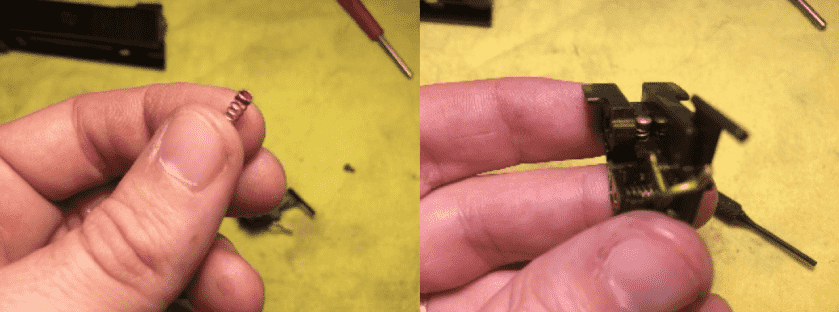
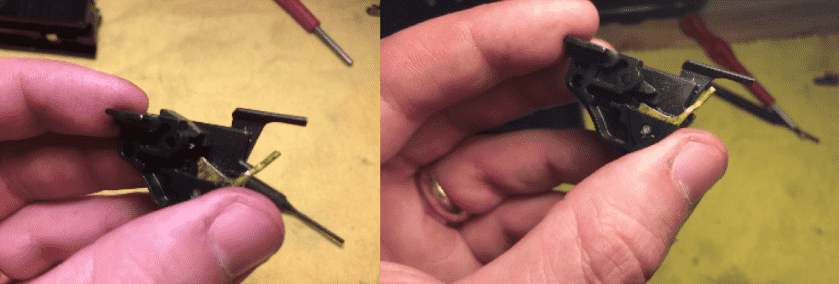 Install the Apex Tactical sear and sear spring along with the factory sear plunger. Place a small amount of grease on the sear spring before installation. The installation process is the opposite of the sear removal process. Once the pin is in place, use the yellow take down lever to check the articulation of the sear (i.e., move the yellow bar up and down to make sure the sear rotates smoothly).
Install the Apex Tactical sear and sear spring along with the factory sear plunger. Place a small amount of grease on the sear spring before installation. The installation process is the opposite of the sear removal process. Once the pin is in place, use the yellow take down lever to check the articulation of the sear (i.e., move the yellow bar up and down to make sure the sear rotates smoothly).
STEP 7

Remove the locking block and slide lock lever, then remove the trigger, trigger bar, and trigger return spring. All of these components should come right out of the frame.
STEP 8

Disassemble the trigger mechanism by removing the return spring and punching out the trigger pin with a 3/32” punch. Apex also recommends polishing the end of the trigger bar with an emery board or other polishing implement.
STEP 9
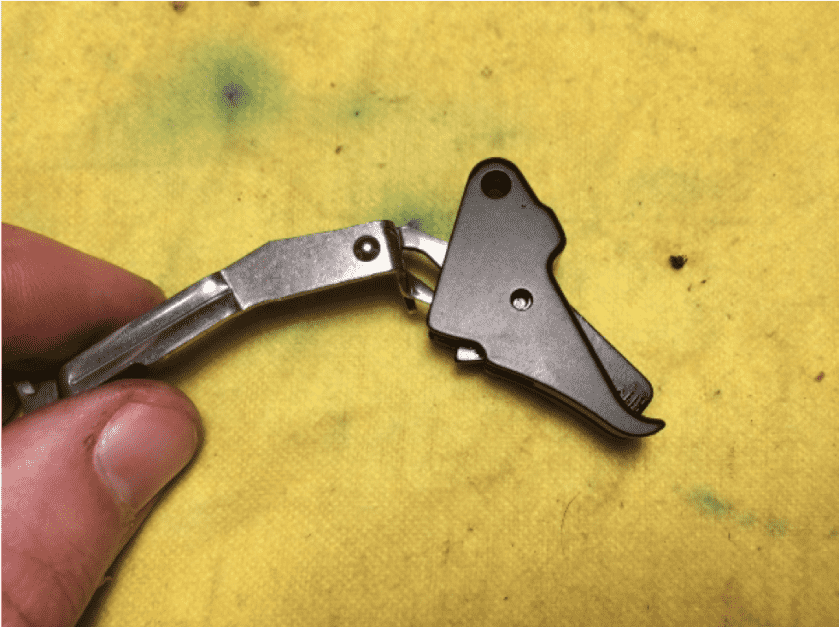
Insert the trigger bar into your new Apex Tactical trigger. Apex has seated the trigger pin so that the trigger bar will snap into place.
STEP 10

Push the trigger pin the rest of the way through the trigger. Believe it or not, this is one of the toughest steps in the whole process. Apex Tactical’s instructional video makes it look like a piece of cake—it isn’t. The pin is super tight. The best strategy is to use a vise with smooth jaws and slowly push the pin through. My vise doesn’t have smooth jaws, so I went full redneck rigged a piece of flat metal to each side. Once you have the pin most of the way through, you can use a punch to make sure it’s flush on both sides.
STEP 11

Install the Apex Tactical trigger return spring and green slave pin. Important: Be sure to install the spring with the hook’s opening facing upwards, towards the top of the spring (as pictured). This ensures the spring doesn’t work its way off during use. To install the slave pin, you might have to use a small screwdriver to push the spring into position.
STEP 12

Before you reassemble the frame components, it’s important to test the articulation of the trigger. To do this, reinstall the trigger pivot pin and pull the trigger as you hold down the trigger bar. If the trigger seems to stick at any point, simply polish the sides of the trigger housing with an emery board or other polishing implement.
STEP 13

Now it’s time to reassemble the lower half of the firearm. Begin by dropping the trigger assembly into the frame, followed by the locking block and slick lock lever. Notice the two angled bosses on the front of the locking block. These bosses slide into matching grooves in the frame.
STEP 14
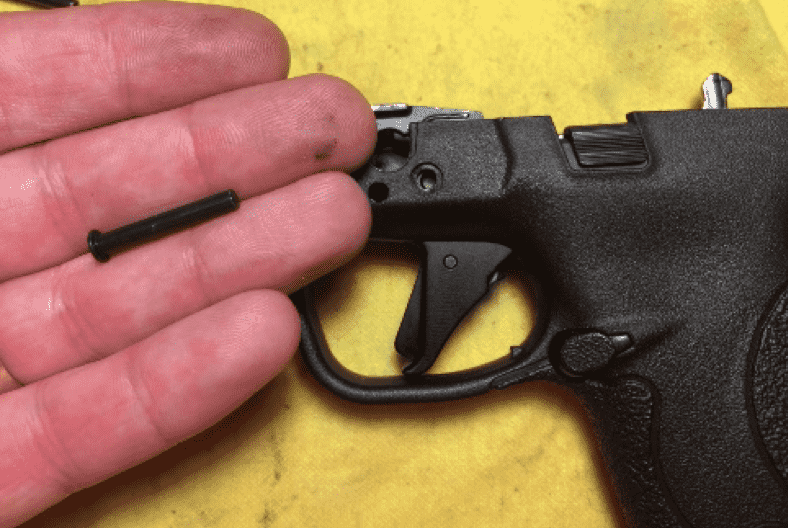
Reinstall the trigger pivot pin. You’ll likely have to pull the trigger to align the green slave pin in the trigger pivot pin hole.
STEP 15

Install the sear housing block back into the frame. This was probably the second toughest step in the process. The trigger extension fits into a notch on the housing block, but at first it doesn’t look like there’s enough room to move the block as far forward as it need to go. I was able to squeeze it in by pulling the trigger and inserting the block at an angle. After about 15 minutes of fiddling, it finally seated properly.
STEP 16
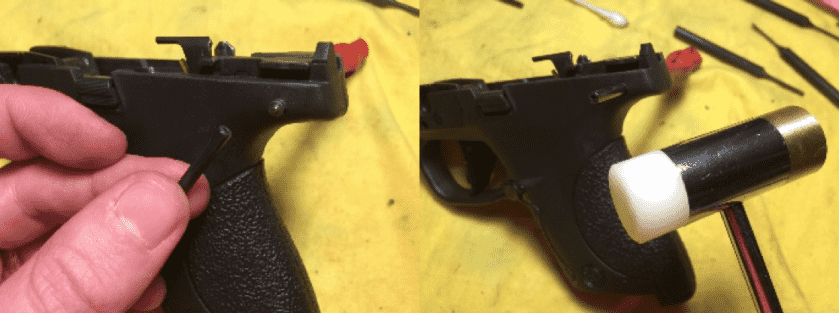
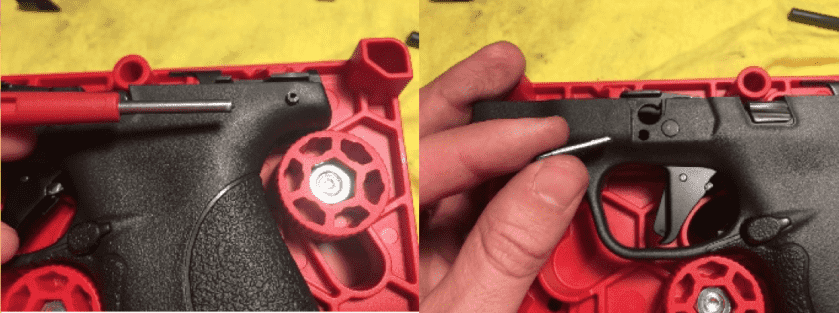 Reinstall the frame pins from the left to the right. For the rear pin, I found it helpful to use the 1/8” roll pin punch as a slave pin. Use a nylon hammer to punch the pin most of the way through, and use the roll pin punch to get it flush. The front pin can be reinstalled without the use of a slave pin.
Reinstall the frame pins from the left to the right. For the rear pin, I found it helpful to use the 1/8” roll pin punch as a slave pin. Use a nylon hammer to punch the pin most of the way through, and use the roll pin punch to get it flush. The front pin can be reinstalled without the use of a slave pin.
STEP 17
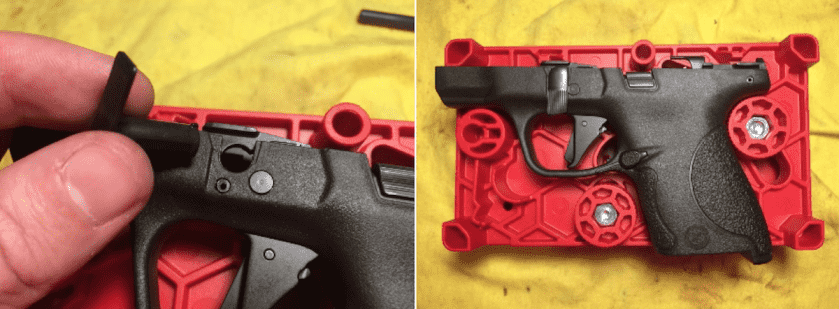
Reinstall the take-down lever. Don’t forget to rotate the lever so that tab fits into the notch on both sides of the locking block.
STEP 18

Now that you’re done with the frame components, it’s time to begin working on the slide. The kit includes an Ultimate Striker Block, a striker block spring, and a Talon Tactical sight installation tool. Start by using a 1/16” Allen wrench to completely remove the rear sight screw. Mine had red Loctite on it, but I was still able to remove it with a wrench without heating up the Loctite.
STEP 19
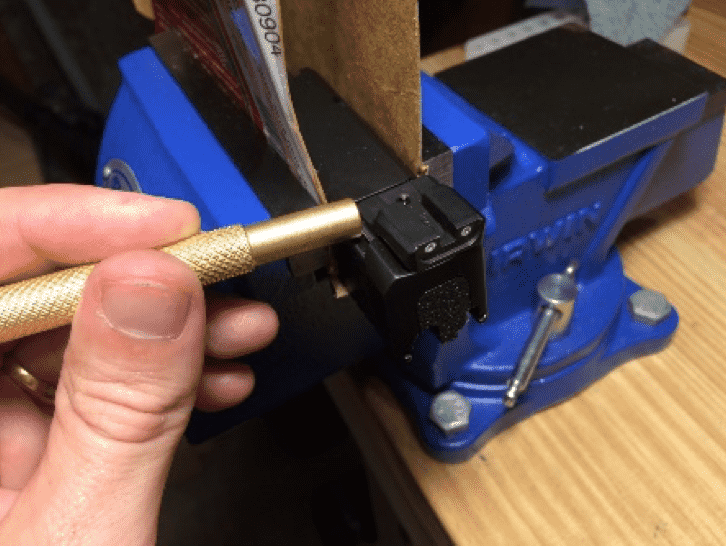
Remove the barrel and barrel spring, secure the slide in a vise, and begin tapping out the rear sight. Be sure to place something in between the vise jaws and the slide to prevent damage. Leather, rubber, and cardboard all work fine. I used a large brass punch and full-sized hammer to tap out the sight. It’s important to use a brass punch—otherwise, you’ll mar the sight. It was tightly seated, but it moved eventually.
STEP 20

Once the sight is almost all the way off the slide, remove the sight by hand. Underneath the sight you’ll find a washer and a spring. Remove the washer, spring, and striker block from the slide.
STEP 21
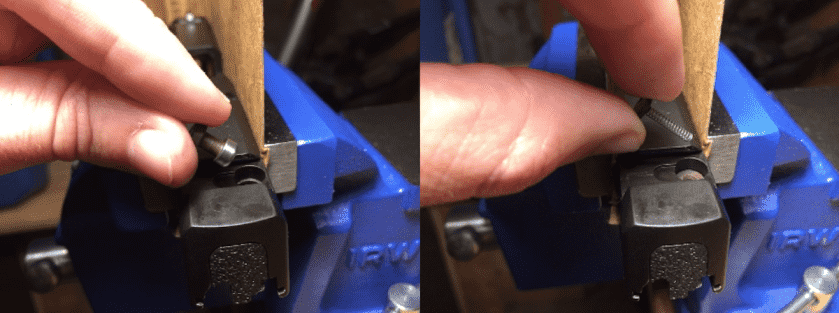
Place the Ultimate Striker Block in the frame with the polished side facing downwards. Seat the Apex striker block spring on the washer, and place them in the frame as well.
STEP 22
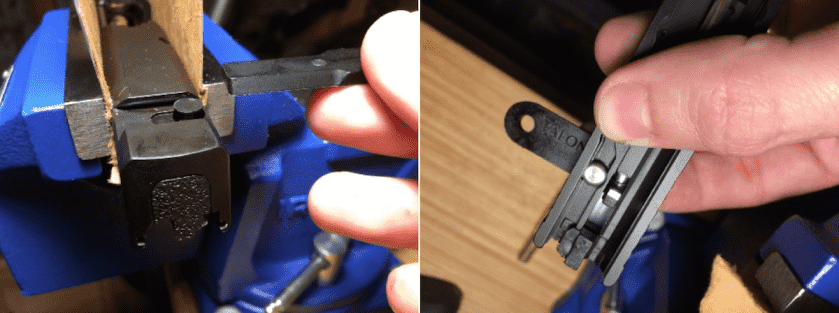
Use the Talon Tactical tool to keep the spring and washer flush with the slide. At this point you’ll want to test the striker block to make sure it articulates smoothly. If there’s any serious resistance, the spring may have come off the washer or be seated crookedly.
STEP 23
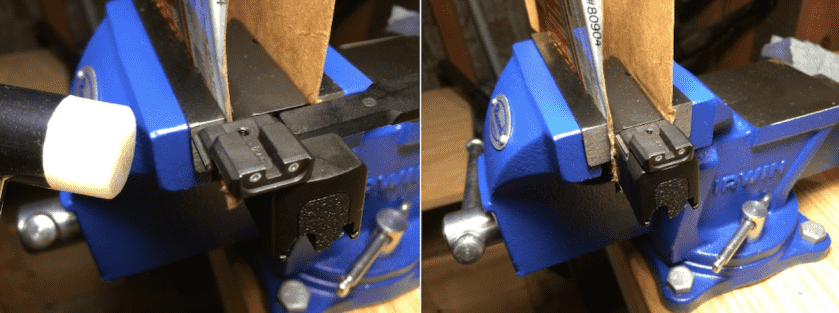
Reinstall the rear sight, pushing it through from the left to the right. I visually centered the sight, as I don’t mind re-zeroing the gun at the range.
STEP 24
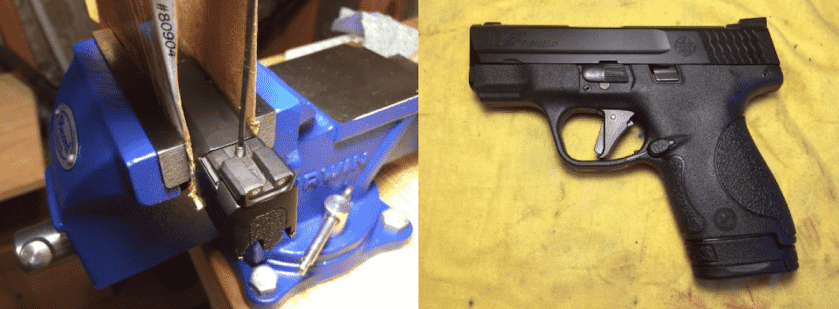
Reinstall the sight screw. You can use a fresh coat of Loctite if you think it’s necessary. Reinstall the barrel and barrel spring, secure the slide to the frame, and you’re done!
Conclusion
The Apex Tactical Flat-Faced Trigger and Duty/Carry Kit lightened my trigger pull by approximately 1.5 pounds, but the real benefit comes in the form of smoothness and consistency. The trigger is smooth all the way through the pull, and I get a crisp, clean 6-pound break every time. The reset is a single, tactile click.
After taking the gun to the range, I noticed that where before I struggled to keep the pad of my finger on the trigger (it would slip down to the knuckle), I can now use proper form every time. This allows me to fire more quickly without moving my finger’s position on the trigger and disturbing my point of aim.
Overall, I think the Apex Trigger is a great purchase, especially for a concealed carry gun. In a self-defense situation, you want to know exactly when your gun is going to fire. That means you need a smooth, consistent trigger, and that’s exactly what you’ll get with Apex Tactical’s product.
You can purchase the kit I reviewed for $164.95 here. Apex also sells the trigger and duty/carry kit separately, so you can purchase whichever you think will best meet your needs.
For more information, visit https://store.apextactical.com/WebDirect/Products/Details/192254.
To purchase a Smith & Wesson M&P Shield on GunsAmerica.com, click this link: https://www.gunsamerica.com/Search.aspx?Keyword=Smith%20Shield.

Put everything in except the striker kit, guns does feel smooth but is it ok to leave out the new striker?
While the “installation” is straight forward troubleshooting the APEX trigger can be a PAIN! Don’t expect much (any) help from APEX.
I have a M&P 9mm c (my EDC) and M&P .45 in the night table – Both guns have Apex triggers and Tijicon HD Night Sights. I’m lazy, I had a gunsmith do the work and set my triggers at 4.5 lbs. I shoot 150 to 200 rounds weekly and the apex triggers have dramatically improved my accuracy, especially in my follow up shots. I’m picking up a Shield soon and will it set up the same, worth every penny!
I have this kit installed in my Shield that I carry everyday. Never understood how people criticize spending money to improve a gun that you bet your life on. I have about 2500-3000 rounds through mine with the Apex kit installed. I shoot it better than most shoot a full size. Worth every penny to me and mine. To each their own, I guess. Also, thought I’d let the author know if you would like the trigger pull a pound lighter, put the stock trigger return spring back in. Enjoyed your review, thank you.
I had bought this kit and installed it. I totally disagree that it is worth the money. The pre-travel feels no different whatsoever. For me, I cannot tell the “lightened my trigger pull by 1.5 pounds” either. To me, this was a complete waste of money. If your finger is sliding down the trigger when pulling it, you have problems with the basics of firing a weapon. I have fired God knows how many 10’s of thousands of rounds in practice, the Service, in the Police Academy, etc. through extreme heat sweating like a pig, and never once has my finger slid down while pulling many triggers of myriads of weapons. It’s ads like this that keep telling me I am wasting my time reading anything from Guns America. This is just an attempt to sell trigger kits for a company that has way overpriced them for what they are. Don’t waste your time trying to call or write. I did and they don’t care. I would love to have the equipment necessary to prove these do not decrease pre travel by 20%. They would be buying back everyone of these kits.
Can a gunsmith lighten and smoothen the stock trigger?
Yes if you have a gunsmith I am sure he/ she can lighten the trigger and improve the reset. Mine got my trigger below 5lbs and the reset is improved.
I installed this exact kit on my Shield 9mm. My group sizes went from 12″ to 6″ with just this change. I got a good price when I bought the Shield, so the cost to improve the trigger was acceptable.
I have 4 shields, 3 40’s and 1 45 and i always thought the pull was pretty decent and after seeing the price to up grade plus the armorers cost i’m really happy with them now but for rich people looks cool. Thanks for FYI
Shouldn’t the rear sight install the reverse of how it was removed? That is right to left? Thanks for the great lesson.